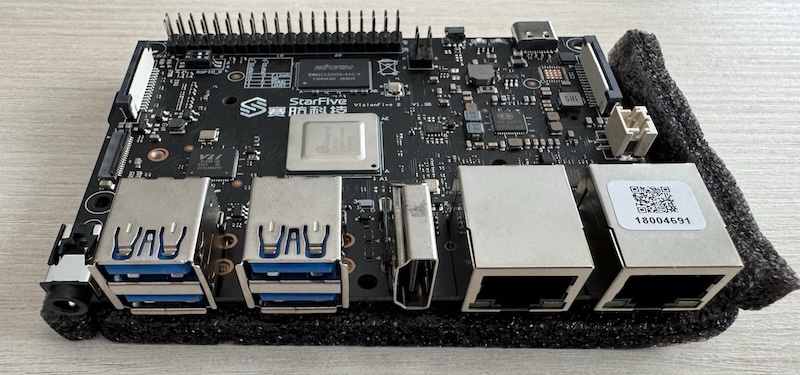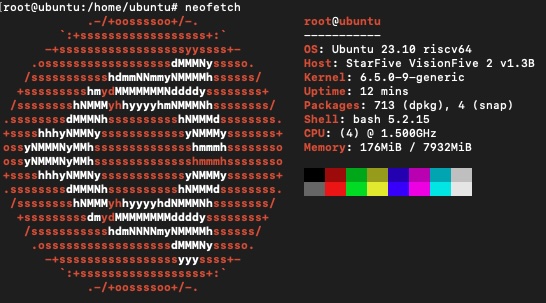StarFive VisionFive2 – The perfect RISC-V Board for Ubuntu – Review

The VisionFive2 board, built on the innovative RISC-V hardware architecture, has found a powerful ally in Ubuntu. The exceptional support that Ubuntu provides for VisionFive2, offering the latest packages for RISC-V architecture, even in current releases down to 24.04 is mind blowing. This stands in stark contrast to other operating systems like Debian and FreeBSD, where integration is still catching up. When you are interested into the RISC-V hardware architecture, you may already have found my posts regarding my first steps and thoughts about this and also my summary of more or less supported operating systems.
Ubuntu has emerged as a front-runner in providing cutting-edge support for the RISC-V architecture, particularly on the VisionFive2 board. The commitment to delivering the newest packages sets Ubuntu apart, allowing developers to leverage the full potential of the RISC-V hardware. Unlike some competitors, Ubuntu doesn’t just promise support for RISC-V; it delivers with the availability of packages dating back to the 24.04 release. This ensures that developers working on the VisionFive2 board (and also other ones like the LicheePi 4a or the Milk-V) have access to the latest tools and updates, fostering an environment of innovation and efficiency.

Debian, a widely respected Linux distribution, struggles to match Ubuntu’s pace when it comes to supporting the VisionFive2 board on the RISC-V architecture. The availability of packages for RISC-V on Debian is limited, with significant integration efforts only starting with Sid. The VisionFive2 board comes mostly with a Debian image shipped which is based on Debian bookworm/sid snapshots (20220616T194833Z, 20221225T084846Z) from 2022 running kernel 5.15. You can find more details for RISC-V on Debian right here. This lag in support could potentially hinder developers looking to take advantage of the VisionFive2’s capabilities. FreeBSD, another operating system known for its reliability, faces notable challenges in providing seamless support for the VisionFive2 board. Issues related to RISC-V integration persist, making it a less favorable option for developers seeking a smooth experience on RISC-V hardware.
What is Ubuntu doing?
Ubuntu’s commitment to providing the latest packages for the RISC-V architecture is a pivotal asset for developers. The availability of up-to-date packages ensures that developers can leverage the latest tools, libraries, and software enhancements. This not only enhances the performance of applications on the VisionFive2 board but also fosters an environment of innovation without compromising stability. A standout feature of Ubuntu in the RISC-V landscape is its robust driver support. The operating system boasts a comprehensive ecosystem of drivers specifically tailored for the VisionFive2 board. This level of support ensures seamless integration and optimal functionality, allowing developers to focus on their projects without the hassle of driver compatibility issues. Ubuntu’s commitment to maintaining a cutting-edge kernel further cements its position as a leader in RISC-V development. The presence of a newer kernel enhances system performance, security, and compatibility with the latest hardware features. Developers benefit from the latest advancements in kernel technology, laying the groundwork for efficient and future-proof RISC-V applications.
How do I proceed on my VisionFive2 board with Ubuntu?
Ubuntu provides an awesome documentation just next to their awesome hardware support. To get Ubuntu on your VisionFiv2 board, Ubuntu provides two ways. You can just download an installer image to your SD card and install Ubuntu to your NVMe or just copy a pre-installed server image to your SD card. The whole process has been made very easy and using the pre-installed server image is just as simple as the following commands on a Linux or Mac machine (please make sure to replace the device with your SD card you want to write):
wget https://cdimage.ubuntu.com/releases/23.10/release/ubuntu-23.10-preinstalled-server-riscv64+visionfive2.img.xz
xzcat ubuntu-23.04-preinstalled-server-riscv64+visionfive2.img.xz | sudo dd bs=1M conv=fsync of=/dev/sdX
Afterwards, you can just boot up your device. It will obtain an IP by DHCP and print all further information to the serial console. If you do not have any serial console in place, you can also scan for the IP by using nmap (nmap -sS -p 22 10.10.10.0/24). SSH can be used for the login by using username ubuntu and password ubuntuwhich must immediately changed after the first login. Afterwards, we will be welcomed by the usual Ubuntu login screen (happy to note that you will see the board’s thermal information now):
Welcome to Ubuntu 23.10 (GNU/Linux 6.5.0-9-generic riscv64)
* Documentation: https://help.ubuntu.com
* Management: https://landscape.canonical.com
* Support: https://ubuntu.com/advantage
System information as of Fri Feb 16 16:28:27 UTC 2024
System load: 0.08
Usage of /: 40.1% of 6.98GB
Memory usage: 5%
Swap usage: 0%
Temperature: 57.1 C
Processes: 120
Users logged in: 0
IPv4 address for end0: 2.192.4.****
IPv6 address for end0: 2a01:c22:b811::beef

In conclusion, Ubuntu emerges as the perfect Linux distribution for conducting initial tests or even production usage on the VisionFive2 board. Its unwavering commitment to providing up-to-date packages ensures developers have access to the latest tools and software enhancements, fostering an environment of innovation and efficiency. Ubuntu’s stellar driver support tailored for the VisionFive2 board minimizes compatibility issues, allowing developers to seamlessly integrate their projects without distractions. Moreover, the operating system’s dedication to maintaining a cutting-edge kernel ensures optimal performance and compatibility with the latest hardware features. For those venturing into the realm of RISC-V development with the VisionFive2 board, Ubuntu stands out as the go-to choice, offering a robust and user-friendly environment for successful and hassle-free initial tests. More information about the VisionFive2 board, including benchmarks, power consumption etc. can be found here and of you have any questions you can ask me in #riscv64:bsd.cafe our Matrix channel.
